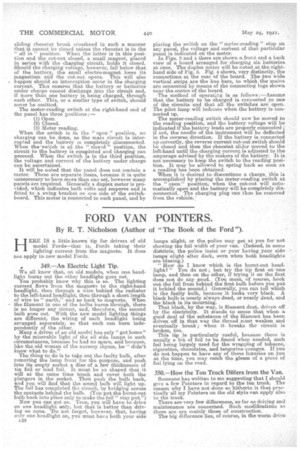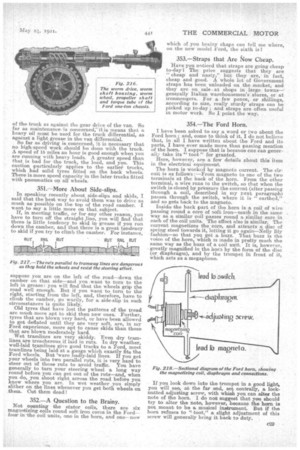FORD VAN POINTERS.
Page 24

Page 25

If you've noticed an error in this article please click here to report it so we can fix it.
By R. T. Nicholson (Author of "The Book of the Ford ").
HERE IS a little-known tip for drivers of old model Fords—that is, Fords taking their lighting current from the magneto. It does not apply to new model Fords.
• • 349.—An Electric Light Tip.
We all know that, on old models, when one headlight burns out the other headlight goes out. You probably know why this is so. The lighting current flows from the magneto to the right-hand headlight, then through a wire behind the radiator to the left-hand headlight, then through a, short length of wire to" earth," and so back to magneto. When
the filament in one of the bulbs burns through, there is no longer any circuit, and, therefore' the second bulb goes out. With the new model lighting things are different, the wiring of each headlight being arranged separately, so that each can burn independently of the other. Many a driver of an old model has only " gothomo" by the miserable light of the oil side lamps in such circumstances, because he had no spare, and because, like the old woman of the nursery rhyme, he " didn't know what to do."
The thing to do is to take out the faulty bulb, after removing the lamp front for the purpose, and push into its empty socket a disc of a few thicknesses of tin foil or lead foil. It must be so shaped that it will at the same time touch and cover both the plungers in the' socket. Then push the, bulb back, and you will find that the sound bulb will light up.. The foil has completed the circuit, by bridging across the contacts behind the bulb. (You put the burnt-out bulb back into place only to make the foil" stay put.") Now you can get on. True, you will have to drive on one headlight only, but that 3 s better than driving on none. 'Do not forget, however, that, having only one headlight on, you must have both your side
lamps alight, or the police may get at you for not showing the full width of your van. (Indeed, in some districts, the police insist or your having your side lamps' alight after dark, even when both headlights are blazing.)
"flow do I know which is the burnt-out headlight " You do not; but try the tip first on ono lamp, and then on the other, if trying it on the first does not do any good. (You must, of course, hook out the foil from behind the first bulb before you put it behind the second.) Generally, you can tell which is the faulty bulb, because it looks. very black. A black bulb is nearly always dead, or nearly dead, and the black is its mourning.
That black, by the way, is filament dust, driven off by the electricity. It stands to sense that when a good deal of the substance of the filament has been driven off in that way the thread must weaken and eventually break ; when it. breaks the circuit is broken, too. This tip is particularly useful, because there is usually a bit of foil to be found when needed, such foil being largely used for the wrapping of tobacco, . cigarettes, chocolates, and tangerine Granges. If you do not happen to have any of these luxuries on you at the time, you may catch the gleam of a piece of foil lying on the road.
350.—How the Ton Truck Differs from the Van.
Someone has written to me suggesting that I should give a few Pointers in regard to the ton truck. The reason why I have not done so hitherto is that practically all my Pointers on the old style van apply also to the truck.
There are very few differences, so far as driving and maintenance are concerned. Such modifications as there are are mainly those of construction. The big difference lies, of course, in the worm drive
of the truck as against the gear drive of the van. .So far as maintenance, is concerned,-ifis means that a heavy oil must be used for the truck differential, as against a light grease in the van differential.
So far as driving is concerned', it is necessary that ne high-speed work should be done with the truck. A speed of 15 miles an hour is good enough when you are running with heavy loads. A greater speed than that is bad for the truck, the load, and you. This caution particularly applies to the earliei• trucks, which had solid tyres fitted an the back wheels. There is more speed capacity in the later trucks fitted with pneumatics on all wheels.
351.----More About Side-slips.
In speaking recently about side-slips. and skids, I said that the best way to avoid them was to drive as much as possible on the top of the road camber. want to say a little more on that subject.
If, in meeting traffic, or for any other reason, you have to turn off the straight line, you will find that there is little tendency to skid in grease if you run down the camber, and that there is a, great tendency to skid if you try to climb the camber. For instance, suppose you are on the left of the road—down the camber on that side—and you -want to turn to the left in grease: you will find that the wheels grip the road well enough. But if you want to turn to the right, starting from the left, and, therefore, have to climb the camber, go warily, for a side-slip in such circumstances is quite likely. Old tyres that have lost the patterns of the tread are much more apt to skid than new ones. Further. tyres that are blown very hard, or have been allowed to get deflated until they are very soft, are, in my Ford experience, more apt to cause skids than those that are blown moderately hard. , Wet tramlines are very. skiddy. Even dry tramlines are treacherous if laid in ruts. In dry weather, well-laid tramlines give good tracks to a. Ford, most tramlines being laid' at a gauge which exactly fits the Ford wheels. But 'ware badly-laid lines. If you get your wheels into two parallel ruts, it is very hard to steer out of those ruts to avoid traffic. You have generally to turn your steering wheel a long way round before you can get out of the ruts—and, when you do, you shoot right across the road before you know where you are. In wet weather you simply slither on the lines whenever you get both wheels on them. Out them dead!
352.—A Question to the Brainy.
Not counting the stator coils, there are six magnetizing coils round soft iron cores in the Ford— four in the coil units, one in the horn, and one—now
which of you brainy chaps can tell me where, on the new model _Ford, the sixth is?
353.—Straps that Are Now Cheap.
Have you noticed that straps are going cheap to-day? The price suggests that they are " cheap and nasty," but they are, in fact, cheap and good. A 'whole lot of Government straps has been unloaded on the market, and they are on saleat shops in large towns— generally Italian warehousemen's stores or at ironmongers. For a few pence, or shillings, according to size, really sturdy straps can be picked up to-day ; and straps are often useful in motor work. So I point the way.
354.—The Ford Horn.
I have been asked to say a, word or two about the Ford horn; and, come to think of it, I do not believe that, in all I have written about the, Ford and its parts, I have .ever made more than passing mention of the horn. I suppose that is because one can generally take its " toot" for granted.
Here, however, are a few details about this item in the electrical equipment.
The horn is worked by magneto current. The circuit is as follows. —From magneto to one of the, two terminals at the back of the horn. From the other terminal, a wire runs to the switch, so that when the switch is closed by pressure the current (after passing through a coil, described in my next paragraph) passes through the switch, where it, is " earthed," and so gets back to the magneto.
Inside the back part of the horn is a coil of wire passing round a core of soft iron—much in the same . way as a similar coil passes round a similar core in each of the coil units. The effect also is similar. The current magnetizes the core, and attracts a disc of spring steel towards it, letting it go again—Nelly Bly fashion—so that you get a buzz. That buzz is the voice of the horn, which is made in pretty much the same way as the buzz of a coil unit. It is, however, greatly magnified in the horn by the form of the disc (or diaphragm), and by the trumpet in front of it, which acts as a megaphone.
• li you look down into the trumpet in a good light, you will see, at the far end, set centrally, a locknutted adjusting screw, with which you can alter the note of the horn. I do not suggest that you should try to alter the note, however, because the horn is not meant to be a musical inarument. But if the horn refuses to "toot,' a slight adjustment of this screw will generally bring it back to duty.
































